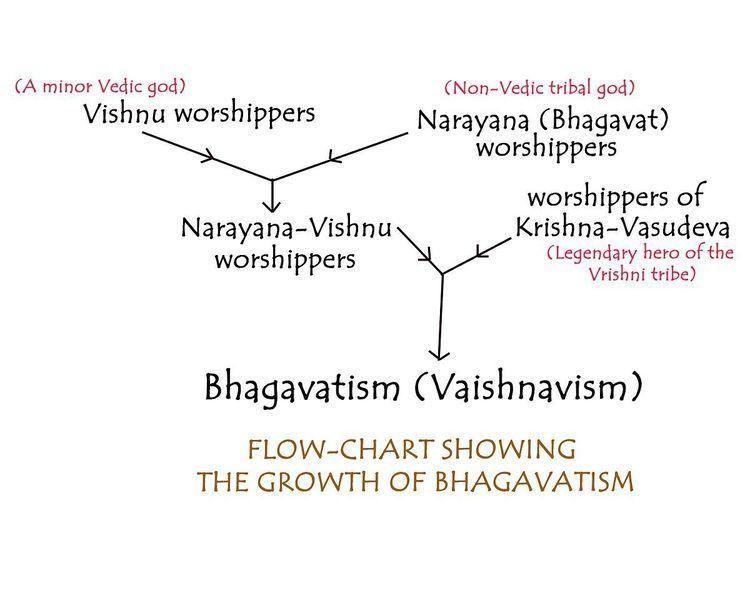 | ||
In Hinduism a Bhagavata (a vrddhi formation from Bhagavan, meaning "devotee of Bhagavan" , the Lord, i.e. God), is a devotee, worshipper or follower of Bhagavan namely God in His personal aspect. The form of worship is called bhakti which has the meaning of 'adoration'. Bhagavat or Bhagavan means 'the Adorable One', whereas Bhagavata indicates a worshiper of the Adorable One. It also refers to a tradition devoted to worship of Krishna, later assimilated into the concept of Narayana where Krishna is conceived as svayam bhagavan. According to some historical scholars, worship of Krishna emerged in the 1st century BC. However, Vaishnava traditionalists place it in the 4th century BC. Despite relative silence of the earlier Vedic sources, the features of Bhagavatism and principles of monotheism of Bhagavata school unfolding described in the Bhagavad Gita as viewed as an example of the belief that Vasudeva-Krishna is not an avatar of the Vedic Vishnu, but is the Supreme.
Contents
Definition of Krishnaism
In the ninth century CE Bhagavatism was already at least a millennium old and many disparate groups, all following the Bhagavata Purana could be found. Various lineages of Gopala worshipers developed into identifiable denominations. However, the unity that exists among these groups in belief and practice has given rise to the general term Krishnaism. Today the faith has a significant following outside of India as well. Many places associated with Krishna such as Vrindavan attract millions of pilgrims each year who participate in religious festivals that recreate scenes from Krishna's life on Earth. Some believe that early Bhagavatism was enriched and transformed with powerful and popular Krishna tradition with a strong "human" element to it.
Initial History of Bhagavata tradition
It is believed that Bhagavatas borrowed or shared the attribute or title Purusa of their monotheistic deity from the philosophy of Sankhya. The philosophy was formulated by the end of the 4th century BC and as time went other names such as Narayana were applied to the main deity of Krishna-Vāsudeva.
Second Early Stage
Some relate absorption by Brahmanism to be the characteristic of the second stage of the development of the Bhagavata tradition. It is believed that at this stage Krishna-Vāsudeva was identified with the deity of Vishnu, that according to some belonged to the pantheon of Brahmanism.
Rulers onwards from Chandragupta II, Vikramaditya were known as parama Bhagavatas, or Bhagavata Vaishnavas. The Bhagavata Purana entails the fully developed tenets and philosophy of the Bhagavata cult whereis Krishna gets fused with Vasudeva and transcends Vedic Vishnu and cosmic Hari to be turned into the ultimate object of bhakti.
Other meanings
In the recent times this often refer to a particular sect of Vaishnavas in West India, referring to themselves as 'Bhagavata-sampradaya'.
It is also a common greeting among the followers of Ramanujacharya and other yoga sects.
Constant Satsanga with devotees and Bhagavatas, repetition of His Name, Sri Ram, Sita Ram, Hari Om, etc., constant remembrance of the Lord, prayer, study of religious books such as the Ramayana, the Bhagavata, Hari Kirtan, service of ... It can also be spelled 'Bhagavats' and refer to a Buddhist concept.
Bhagavata Sampradaaya is a very old vedic tradition that respects all the darshana shastras & siddantas. It is neutral to any particular practices like only Vaishnava, Smarta, Shakta, Gaanapatya, Saura etc., And instructs to practice the rituals that is in accordance with Vedas. Some of the practices of this Sampradaaya are continuous study of Vedas, all time chanting of Gayatri, Nitya Agni Upaasana, Atiti Satkaara, Vaishwadeva, Pancha Yagnas, Daana-Dharma, Simpleness, humbleness, socially accepted life style, Sachitdananda Dhyana, leaving egotism, Sarva samarpana Bhaava of one's own Sampat-Bhakti-Punya Karma-Knowledge. This is actual Bhagavata.
